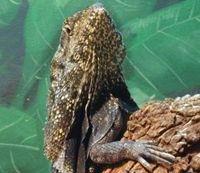Agama - Frilled Dragon
Bicycle Lizard Scientific Name: Chlamydosaurus kingii
Mon, 30th June, 2025 - 11:04 pm GMT
Sponsor Ads:

Alternative Name
Bicycle Lizard Scientific Name: Chlamydosaurus kingiiBasic Info
Frilled Dragons range in color from olive to grayish-brown to nearly all black. Their frill ranges in color from yellow to orange to jet-black, along with spots of orange, red, and white. At maturity, they will reach a length of 30 inches from nose to tail. The body is about 10 inches in length. The frill is large, measuring up to 14 inches.
Health
An adult Frilled Dragon is far too large to house comfortably in a standard terrarium, so be prepared to purchase a cvostly custom terrarium or enclosure or to build one yourself. Males should be kept separated. Frilled Dragons love to climb and in captivity, this should be accommodated. Climbing branches will work well inside their housing. These branches should be of the same thickness as the lizard or thicker, to be sure that it will support their weight. Frilled Dragons should be exposed to full spectrum UV lighting for about 13 hours a day. Place a water dish in the cage and keep the basking temperature in between 90 and 95 degrees, misting often to keep humidity levels stable. Keep the temperature in between 80 and 85 degrees during the day and above 70 degrees at night. They can be fed insects, fish or shrimp, canned reptile food(for carnivorous reptiles), small mammals, and cooked eggs. Ideally, food items should always be dusted with a calcium supplement. A multivitamin supplement is recommended about twice a week for adults and every feeding for juveniles. If feeding a commercial reptile food, it may be best to avoid adding a supplement to this food, as it often contains appropriate amounts of vitamins and minerals already, and too much of a vitamin can be just as bad for your lizard as too little. Some Frilleds are finicky and seemingly become bored with certain food items if their diet is not varied enough. and Propagation: Relative Breeding Ease: Uncertain Hatchlings are 5 inches long and weigh approximately 3 to 5 grams. As juveniles, they are difficult to sex. They grow fairly quickly and may be as long as 16 to 18 inches within the first year. Most will live about 15 years in captivity.Habitat
Northern coastal portion of Australia and the southern part of New Guinea.Behavior
Frilled Dragons got their name from their ability to extend huge flaps of skin on their neck as aggressive/defensive displays, or to show off for females.They are Agamids, like the Bearded Dragon. Frilled Dragons are docile, active, and very curious. They love to climb and are very active in captivity. Overall, they are intelligent and calm, only becoming aggressive when they feel threatened. When they are frightened, their unique defensive posture kicks in; they enlarge and rattle their massive frill and then make hissing sounds, with their mouths in an aggressive expression. If frightened, they may flee on two feet. It should be noted that once Frilleds become accostomed to their captive environment, most will rarely, if ever, display their frill. Sexing is relatively hard, but males will begin to show hemipenal bulges around six months.Origin
AustraliaHistory
They are large arboreal lizards in the northern coastal portion of Australia and the southern part of New Guinea.Common Foods
Flying Dragons eat insects. They catch such prey by sitting under a tree until an insect passes by, and then they eat it. In captivity, Flying Dragons will do well when fed on worms, flies, crickets, wax worms, or ants.Sponsor Ads:
Thoughts on Programming, Number 22: The programmer, like the poet, works only slightly removed from pure thought-stuff. -The Mythical Man-Month Frederick P. Brooks, Jr.
Agama - Frilled Dragon
Coded by: BGID® | ALL RIGHTS RESERVED Copyright © 2000-2025
Disclaimer | Privacy | Report Errors / Contact | Credits








 Preparing For China. China is growing their military. China Military Technology - can it keep up with the US?
Preparing For China. China is growing their military. China Military Technology - can it keep up with the US?  versus
versus 

 versus
versus 
 This Thread is about the North Korean Military itself - the kind of army, navy, and air force they have.
This Thread is about the North Korean Military itself - the kind of army, navy, and air force they have. 
 versus
versus 
 versus
versus  versus
versus